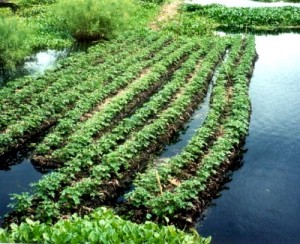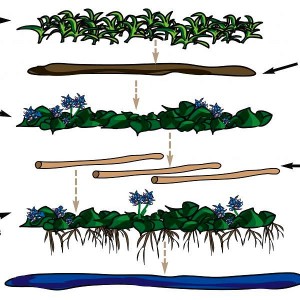 Floating gardens is a clever solution for people who live in areas covered by water during the monsoon season where it is impossible to grow crops. Practical Action has developed a technology to allow farmers to grow food on flooded land.
Floating gardens is a clever solution for people who live in areas covered by water during the monsoon season where it is impossible to grow crops. Practical Action has developed a technology to allow farmers to grow food on flooded land.
To make a floating garden, it employs the use of water hyacinth, which is collected to construct a raft. This is then covered with soil and cow dung, in which vegetables can be planted. A new raft needs to be built every year, but the old one can be used as fertilizer during the dry season.
The rafts, eight meters long and one meter wide, are made from hyacinth which is available for free locally. Soil is put on the surface of the raft and then the seeds planted in the soil. Summer and winter vegetables such as gourd, okra and leafy vegetables are grown.
The floating gardens provide vital food for people even during the annual monga (period of food shortages) and they can also provide an alternative source of income through sale of any surplus in the market. The rafts can be moved from place to place so are also suitable for those that have temporarily or permanently lost their homes and land.
Training is provided in new techniques to cope with the conditions in order to grow more and better crops throughout the year. People are shown how to protect against plant disease and insect attack using organic control methods (e.g. home made botanical insecticide). Advice is also given in making seed-beds, preparing compost and enriching the sandy soil with compost and manure.

Source and Photos: www.practicalaction.org